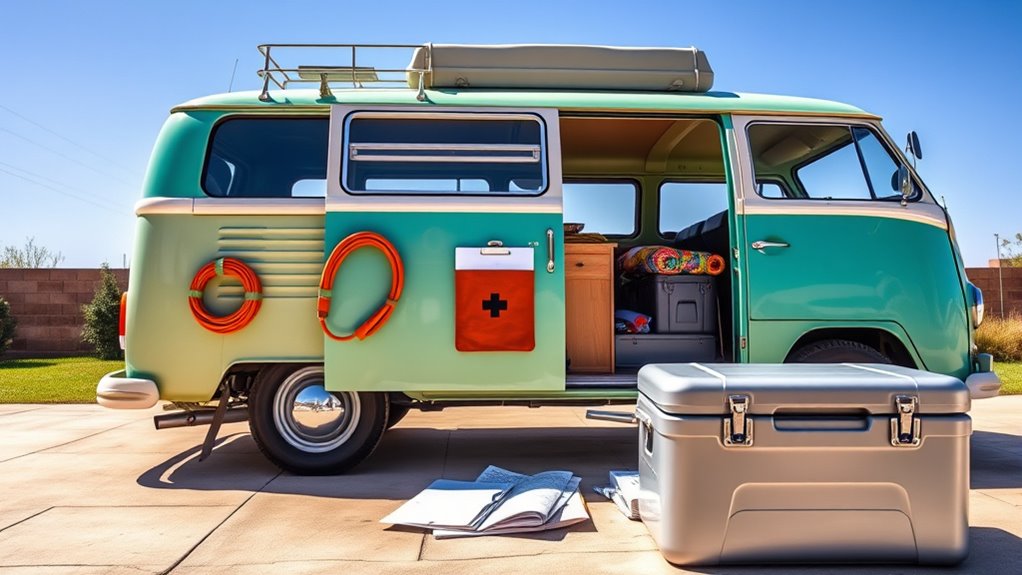To prepare your VW Bus for a cross-country trip, start by inspecting and topping off all fluids, checking the brakes, belts, hoses, and tire condition, including spare. Pack essentials like a first aid kit, tools, extra fluids, and layered clothing. Plan your route, confirm your phone’s charged, and carry a navigation device. Secure loose items, organize the interior, and verify vehicle documentation and safety gear. Continuing further will help you cover every detail for a safe adventure.
Key Takeaways
- Conduct a thorough vehicle inspection, focusing on brakes, tires, belts, hoses, and fluid levels.
- Pack essential safety and maintenance items, including a first aid kit, tools, fluids, and spare parts specific to your VW Bus.
- Plan your route carefully, including fuel stops, rest areas, and overnight accommodations, using reliable navigation tools.
- Prepare the interior by securing loose items, organizing storage, and ensuring comfort for long drives.
- Verify all vehicle documents are current, and carry emergency supplies and repair tools for potential breakdowns.

Planning a cross-country trip in your VW Bus requires careful preparation to guarantee a smooth journey. One of the most important steps is confirming your vehicle is in top shape. Start with thorough vehicle maintenance—check your oil levels, inspect the brakes, and verify that all fluids are topped off. Don’t forget to examine the belts and hoses for any signs of wear, and consider having a professional mechanic do a detailed inspection before you hit the road. A well-maintained vehicle minimizes the risk of breakdowns and keeps you safe during long hours of driving. Additionally, review your tire condition, including the spare, and ensure they have proper pressure. Proper tire care not only enhances safety but also improves fuel efficiency, saving you money over the miles.
Once your vehicle is in good condition, shift your focus to packing essentials. Think about what you’ll need for comfort, safety, and emergencies. Pack a well-stocked first aid kit, a flashlight with extra batteries, and basic tools such as a jack, wrenches, and jumper cables. Don’t forget to bring extra fluids like windshield washer fluid and motor oil. In terms of clothing, prepare for various weather conditions—layered clothing works best, especially if your route crosses different climates. It’s also wise to carry a reusable water bottle, snacks, and a cooler with fresh food to stay energized and hydrated during long stretches without services.
Pack essentials like a first aid kit, flashlight, tools, extra fluids, and layered clothing for a safe, comfortable trip.
You should also plan your route carefully, taking into account fuel stops, rest areas, and potential overnight spots. Having a GPS or a reliable map app helps you stay on track and avoid getting lost. Make sure your phone is fully charged, and carry a portable charger or power bank for backup. Since your VW Bus is a classic, consider bringing along any spare parts or repair supplies specific to your model, in case you encounter minor issues along the way. Double-check that your registration, insurance, and any necessary permits are current and easily accessible.
Finally, prepare your interior to create a comfortable environment for the trip. Secure loose items to prevent them from shifting while driving, and organize your storage to maximize space and accessibility. Regularly checking your sound system can also make long drives more enjoyable and help you stay relaxed. With vehicle maintenance up-to-date and your packing essentials in order, you’ll set yourself up for a memorable, hassle-free cross-country adventure in your VW Bus. Proper planning ensures you’ll enjoy the journey as much as the destination, making every mile enjoyable and safe.
Frequently Asked Questions
How Often Should I Check the Oil During the Trip?
You should check the oil level monitoring at least every 1,000 miles or once a week during your trip, whichever comes first. This helps make certain your oil remains at the proper level and prevents engine issues. Remember, following your VW’s recommended oil change frequency keeps your engine running smoothly. Regular oil checks are quick but essential, especially on long journeys, to avoid unexpected breakdowns and costly repairs.
What Should I Pack for Emergency Repairs?
Did you know that over 70% of roadside emergencies can be handled with just basic first aid and proper tools? When packing for emergency repairs, include a basic first aid kit, essential tools like pliers and screwdrivers, spare fuses, jumper cables, and a flashlight. Don’t forget your emergency contact info, roadside assistance number, and vehicle manuals. Being prepared guarantees you’re ready to handle minor issues and stay safe on your journey.
Is It Necessary to Upgrade My VW Bus’s Suspension?
A suspension upgrade isn’t always necessary, but it can considerably improve your VW bus’s ride comfort, especially on long cross-country trips. If your current suspension feels bumpy or sagging, upgrading can offer better stability and handling. Consider your bus’s condition and your travel needs. A well-maintained suspension ensures a smoother ride, making your journey more enjoyable and less tiring.
How Can I Improve Fuel Efficiency on Long Drives?
Some believe that small tweaks can boost your VW bus’s fuel efficiency. You can start by maintaining proper tire pressure—under-inflated tires waste fuel. Consider aerodynamic modifications, like adding a roof rack cover, to reduce drag. These steps help your engine work less, saving fuel on long drives. Regular maintenance, such as oil changes and engine checkups, also plays a vital role in keeping your bus running efficiently mile after mile.
What Are the Best Routes for Scenic Cross-Country Trips?
You should focus on scenic route planning to find the most breathtaking views and memorable experiences. Look for routes that include off the beaten path destinations, offering unique sights away from crowded highways. Use travel guides, maps, and local recommendations to craft a personalized journey. This way, your cross-country trip becomes an adventure filled with hidden gems and stunning landscapes, making every mile memorable and visually rewarding.
Conclusion
Remember, a stitch in time saves nine. By thoroughly checking your VW Bus before hitting the road, you’re setting yourself up for a smooth, worry-free adventure. Take the time to review your checklist, address any issues, and pack essentials. When you’re well-prepared, the open road becomes a place of discovery and joy. So, stay proactive, trust your prep, and enjoy the journey ahead—because the road awaits those who are ready.









